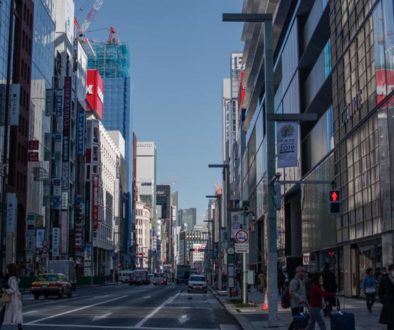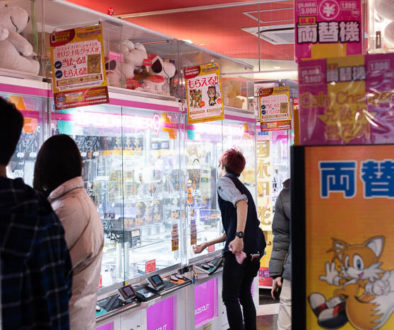Kamakura: the beautiful historical and cultural gem near the coast. A wonderful place to visit, Kamakura is located in the Shonan area, about an hour away from Tokyo. You will feel like you are in a different country. The Shonan area is famous for its beaches, its unique atmosphere, and its cuisine. If you enjoy anything beach related, you are in for a real treat! Let’s explore Kamakura by looking at its history, the landmarks, what to do and, of course, its best bites.
History
Kamakura is one of the most ancient cities in Japan. Today, Kamakura is renowned for its numerous temples and shrines, as well as for its beaches.
Kamakura was the political capital of Japan from the late 12th century to the 14th century. This time period is called the Kamakura Bakufu, or Kamakura Period. The Kamakura period was the start of a new era in Japan. Previously, the imperial court in Kyoto held all of the power, but with the start of the Kamakura period the power shifted to the military. In other words, from the Kamakura period onward, the military-ruled the country. After the fall of the Kamakura Bakufu, Kamakura turned into a nice, quiet place. From the 17th century, it started to flourish as a temple town. Today, it is one of the most popular spots in the area.
Landmarks
Hachimangu Shrine
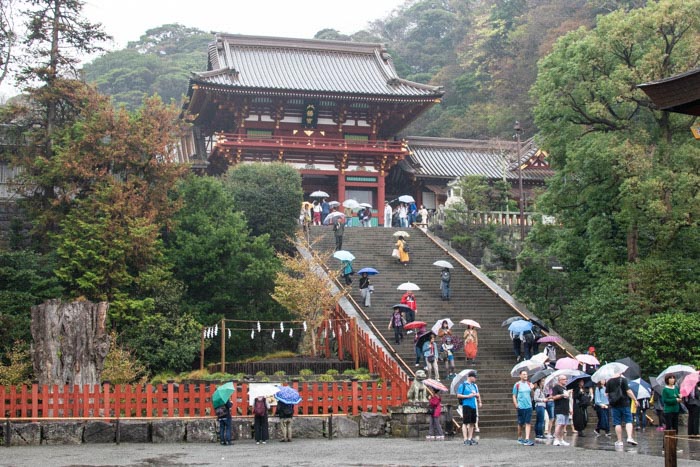
This is one of the largest and most famous shrines in Kamakura. Hachimangu is dedicated to Hachiman, the God of Archery and War. There are numerous ponds and gardens located in the facility and it is beautiful in all seasons. Being located in the center of Kamakura, Hachimangu is always crowded, but the crowds are there for a reason! You will understand the instant you set foot in the shrine.
Buddha Statue (Kōtoku-in)
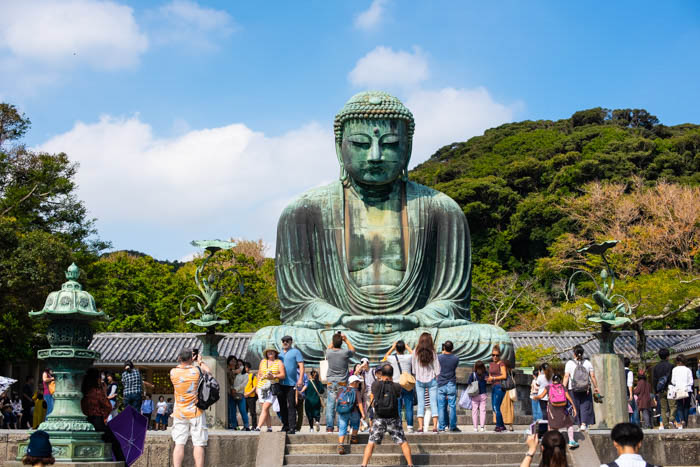
Kamakura has one of the biggest Buddha statues in Japan: the statue of Buddha Amitābha, also known as “The Buddha of Immeasurable Light and Life.” The original statue was made of wood, but it was destroyed by a storm in 1248. The current statue dates back to the year 1252, and used to be contained inside a wooden hall. This hall has been destroyed and rebuilt many times throughout the years, and now the Buddha sits outside without any shelter. But it’s better this way in many people’s opinion, as it makes the statue look more divine. The statue is hollow, so you can also go inside the statue and see how it is made!
Komachi Dori
Komachi Dori is the street that connects Kamakura train station to Hachimangu. Originally a route for “water vendors” in the past, it is now a very popular place loved by locals and travelers. Here you can find many traditional Japanese cuisines and souvenirs. One of my favorites is called “Mameya,” a store that sells various types of beans and nuts. The beans and nuts are coated with various types of traditional and adventurous flavors, including matcha, soy, chocolate, fruits and many more! It will blow your mind! Walk around this street while eating traditional Japanese snacks and enjoy the scenery of Kamakura.
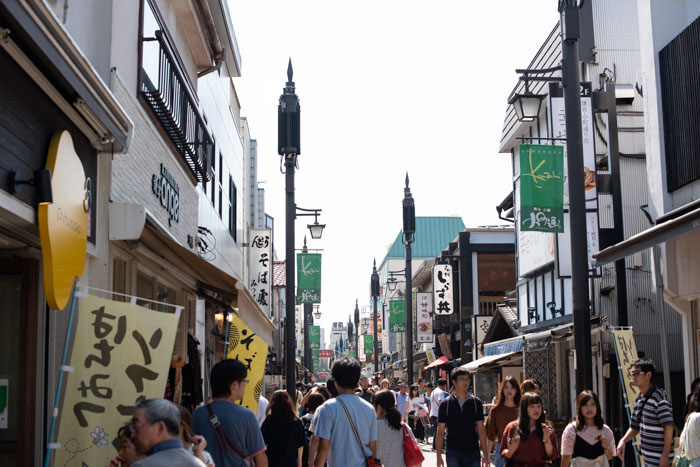
Enoshima/Enoden
Not too far from Kamakura, there is an island called Enoshima. Enoshima is a unique island, as most of the island is covered by various Temples. The temples are dedicated to Benzaiten, the Goddess of Music and Entertainment, who is said to have risen the island from underwater. There is an observatory deck on the top of the island, from which you can see just how beautiful the Shonan area is. A little warning, you will be going up a lot of stairs. There is also an escalator that can take you to the top, but it will cost you a little extra. The stairs are recommended because you will miss some interesting monuments if you decide to take the escalator.
You take a tram called the Enoden to get to Enoshima, whizzing through the busy streets and squeezing through residential areas (literally). You will also have a nice view of the beach while on the tram.
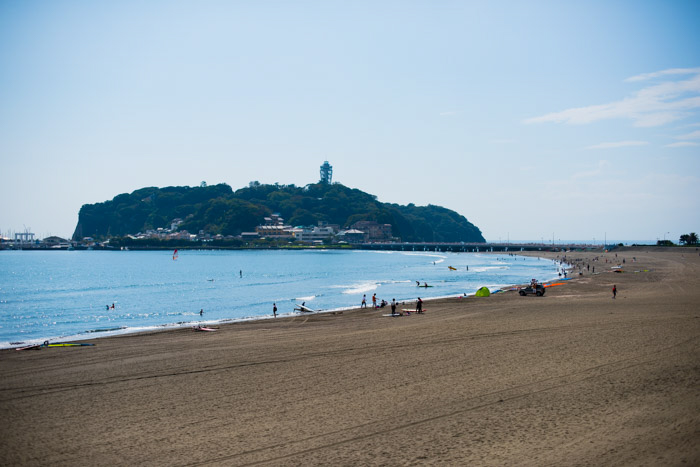
Houkokuji Temple
Houkokuji Temple is by far the most beautiful temple in the Kamakura area. It is a little far from central Kamakura but is definitely worth the trip. The temple is in the mountains, surrounded by gorgeous natural scenery and vegetation. Moreover, behind the temple there is a bamboo garden that you must see. you will be at a loss for words, guaranteed. This temple used to be a place where children came to learn, since temples were originally the first form of schooling in Japan. It must have been nice to learn in such a breathtaking environment.
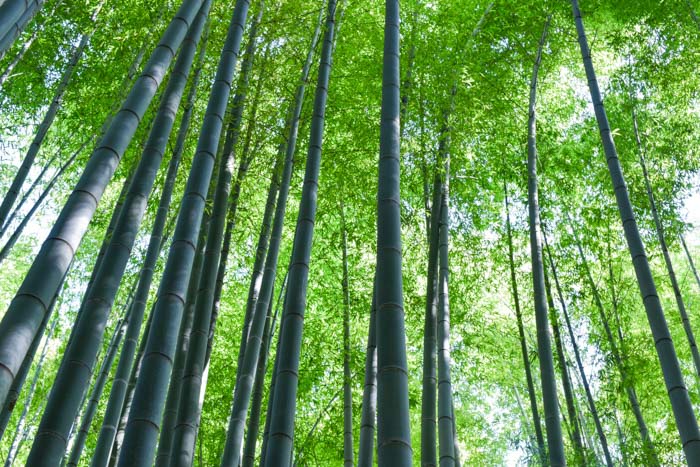
Unique Temples
Being a temple town, Kamakura has many unique temples that you just have to see! We have chosen the most interesting ones and have them listed below. Kamakura is a very spread out area, so the temples tend to be a little far from each other. We recommend using a bicycle rental service to get around instead of walking. Below is a list of the two closest to the train station:
Kamakura bicycle rental shop
Address: 1 Chome-1, Komachi, Kamakura, Kanagawa
Share Cycle COGICOGI CHABAKKA TEA PARKS
Address: 11-10 Onarimachi, Kamakura, Kanagawa
Ofuna Kannon
Two stations away from Kamakura there is an area called Ofuna. Near Ofuna station there is the Statue for the Goddess Kannon, the Goddess of Mercy. The statue is pure white and very beautiful, so if you are in the area you should definitely check it out! Also, Ofuna has many places to shop, and the streets overflow with izakaya, or gastro-pubs.
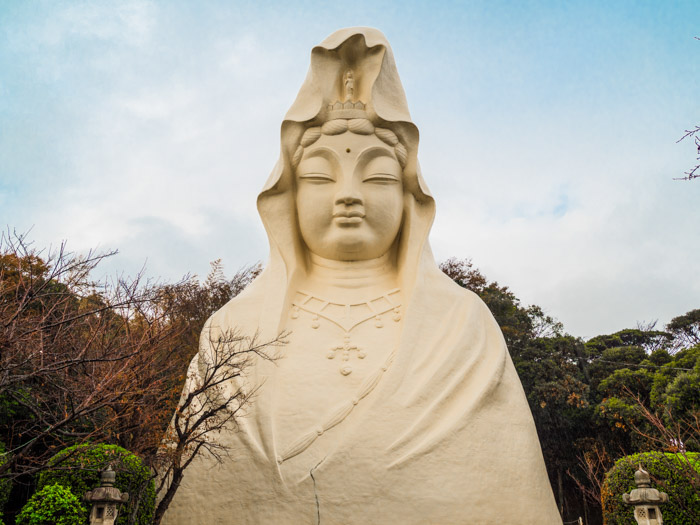
Benzaiten Ugafuku shrine
Built in the year 1185, this shrine is very small, but it is the second most popular destination in Kamakura, next to Hachimangu. This shrine is very unique for two reasons. First, it is a fusion of Shinto and Buddhism, the two main religions of Japan, so there are two divinities worshiped here: the spirit Uga Fukujin (Shinto), and the Goddess Benzaiten (Buddhism). Shinto is the religion that is native to Japan, and in Shinto they worship spirits. There are a countless number of spirits for everything imaginable, similar to the many gods that exist in Buddhism. Second, there is a special watering well in one of the caves located inside the shrine. The water in this cave is said to multiply money when money is washed in it. This ritual is called Zeni-arai. So why not give it a try, it couldn’t hurt to get some extra money, right?
Sugimoto Temple
The oldest shrine in Kamakura that dates back to the year 734. Sugimo Temple is nicknamed Geba Kannon (“Dismount Kannon”), because horsemen never failed to dismount from their steeds when they passed by. According to a different version of the legend, non-believers always fell from their horses when passing in front of the temple. The temple really gives off a special vibe, surrounded by nature with moss growing on the stairs. It is one of the most beautiful places you can visit.
There are countless other interesting shrines and temples in Kamakura, so be sure to bike around and enjoy what this Temple Town has to offer!
What to do in Kamakura
Kimono Rental
Since you are in Japan, and also in one of the most famous Temple Towns, why not get in the traditional Japanese mood and dress up in a kimono! There are various different places that offer kimono rentals. We recommend Vasara, as it is very close to the train station and you can get a nice kimono for a decent price. Walk around and be guaranteed to get the best photo ever!
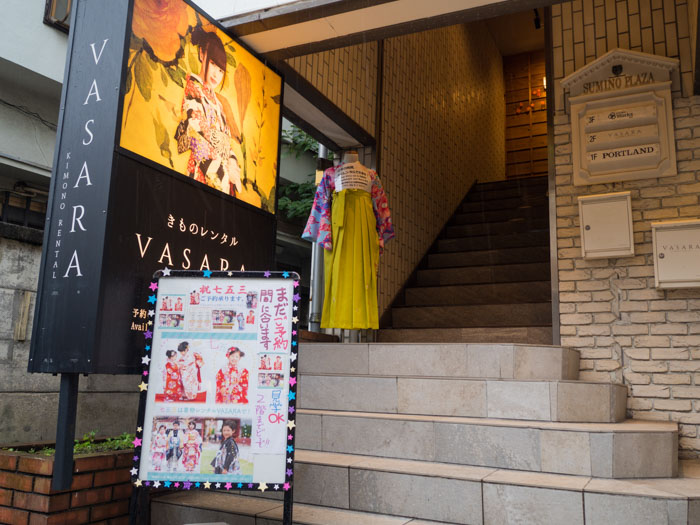
Meditation at a Temple (Zazen)
Zazen is one of the practices of Zen Buddhism, in which one meditates while seated in a strict posture. The aim of zazen is just sitting, suspending all judgmental thinking, and letting words, ideas, images, and thoughts pass by without getting involved in them. Of course, even non-Buddhists are also able to join zazen meetings as long as they are respectful and abide by the rules and etiquette of the temple. However, if you are interested in trying a course like this, you must be able to get up very early in the morning and should wear loose, comfortable clothing.
Click here for a link to sign up for one of the sessions! We recommend Kencho-ji, one of the five zen Buddhist temples in the area that is also the oldest, as it is easier to get to and the experience is way better!
Flyboarding
Have you ever tried Flyboarding before? This is a very new sport where you will attach a machine to your feet, the machine shoots out water and you will use the water pressure to soar into the sky! Because there are not too many places where you can do this in Japan yet, we recommend it! After walking around for the day, give yourself a treat and soar into the sky! I’m sure many people wished they could fly when they were younger, so why not make one of your childhood dreams come true with this unique experience?
Enoshima Island Spa
Walking around all day can be very tiring. At the end of the day, why not wind down and relax while enjoying the great scenery of Enoshima? Here, the spa offers many different onsen, or hot springs, including indoor, outdoor, and even one inside of a real cave! These onsen are mixed, so you can enjoy them with everybody you are going with (and you can wear a bathing suit, don’t worry)! There are also separated areas (no bathing suits allowed) for those of you who want to enjoy the traditional onsen experience. Other options such as Aroma Therapy and massages are also offered. Give yourself a break, you’re on vacation, so take some time to rest that body and get ready for more walking the next day.
What to Eat in Kamakura
Curry
Sangoshou ($-$$)
A very popular curry restaurant that has been featured in magazines and on TV countless times. Here, you can try amazing curry while enjoying a beautiful view of the sea. The decor of the restaurant is also very fancy, which makes you feel as if you are in a high-end beach resort! They are also famous for their garlic potato sticks, which we highly recommend.
Address: 1 Chome, 3-22, Shichirigahama, Kamakura, Kanagawa
Kappou-style Cooking and Soba
Namitokaze ($$-$$$)
Enjoy Kappou-style cooking that is very hard to find elsewhere. Kappou is a traditional Japanese establishment where the owner/cook is visible from the counter or tables and can interact with the customers. This restaurant is famous for their handmade soba. See how traditional soba is made here, along with a variety of fresh seafood dishes. The price is a bit high, but the experience is definitely worth it!
Address: 1 Chome, 16-21, Hase, Kamakura, Kanagawa
Seafood
Tsuruya ($$-$$$)
Enjoy the best fresh unagi in the Kamakura area! This restaurant has been ranked number one in Kamakura for unagi for what seems like forever. Unagi is how we say eel in Japanese, so at Tsuruya you can enjoy the best eel bowl of your life. The location is perfect, near Kamakura’s most famous beach, Yuigahama. Unagi is popular in the summer, as it gives you a boost of stamina. If you get tired from walking or biking all day, it might help to have some unagi for dinner to give you that extra boost.
Address: 3 Chome, 3-27, Yuigahama, Kamakura, Kanagawa
Kaiseki-Style Cooking and Tempura
Akimoto ($$-$$$)
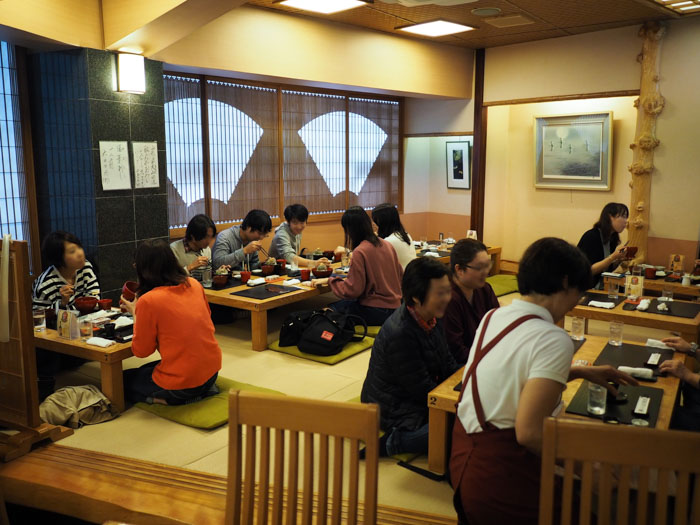
Kaiseki-style cooking is a traditional style of Japanese cooking where you receive a multi-course meal, meaning you get a little bit of many types of dishes. This adds up to a lot of food. The price is a tad high, but you get the chance to try many different traditional Japanese foods, and you are guaranteed to be extremely full by the end. We recommend that you try Kaiseki-style cooking at least once during your stay in Japan.
Address: 1 Chome, 6-15, Komachi, Kamakura, Kanagawa
Shirasu Bowl
Shirasuya ($$)
You may be wondering what a shirasu bowl is–this is the most popular local cuisine in the Kamakura area. Shirasu are baby sardines, about 5cm in length, and a Shirasu bowl will literally be filled with hundreds of these little guys. So pour some soy sauce on top and enjoy! One bite and you will instantly know why this dish is the most popular in the area. If you like your Shirasu bowl, there are many other Shirasu-related foods in the area, so it might be fun to look for them!
Address: 2 Chome, 10-13, Koshigoe, Kamakura, Kanagawa
Get out of the city for a day, and come check out Japan’s coastal Temple Town. You may take a day trip to Tokyo, or you can also stay in Yokohama. Check out Kayak.com to find out the best hotel deals.
You are bound to have one of the best days of your trip here. Enjoy!

